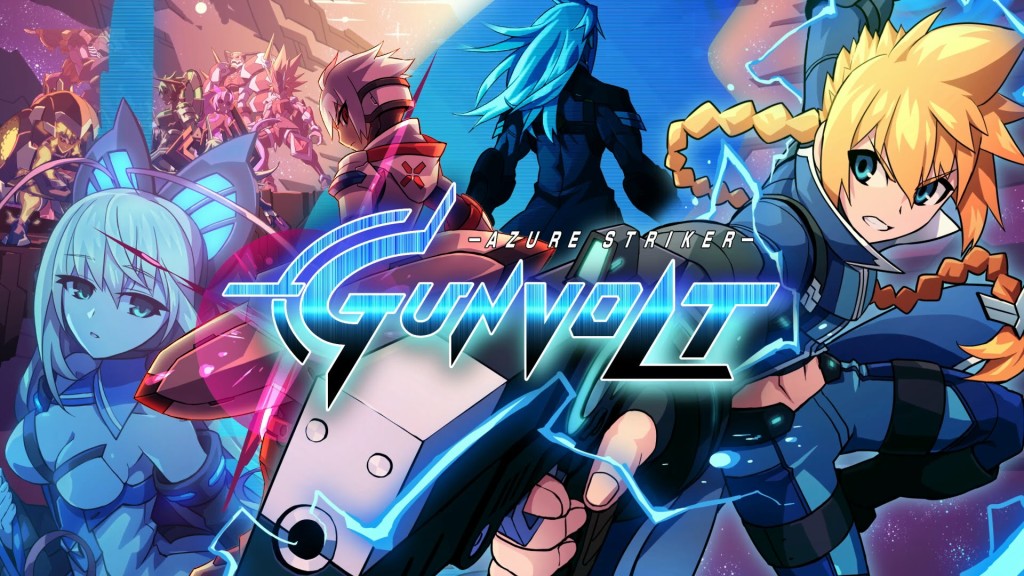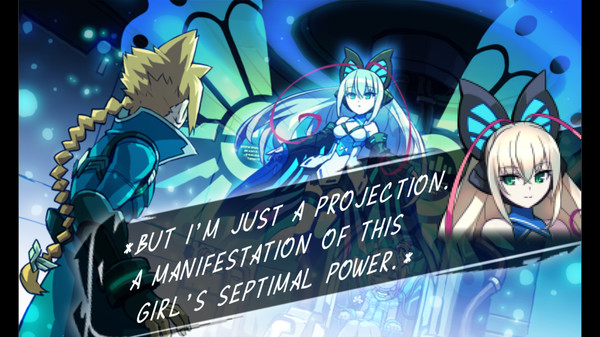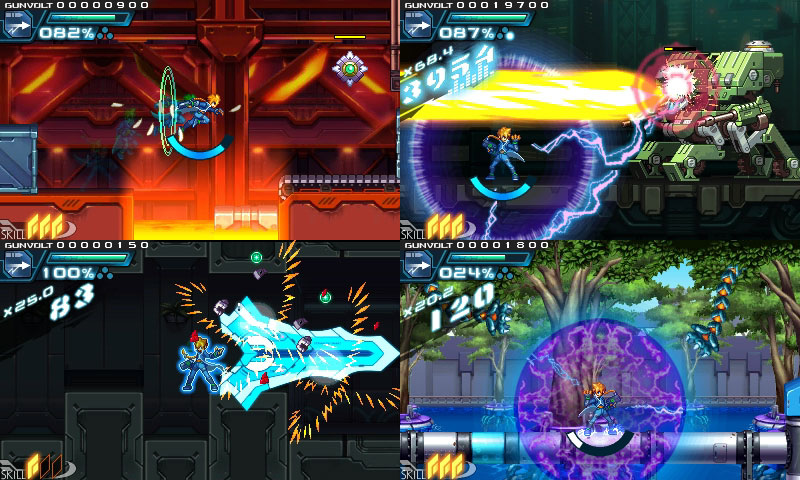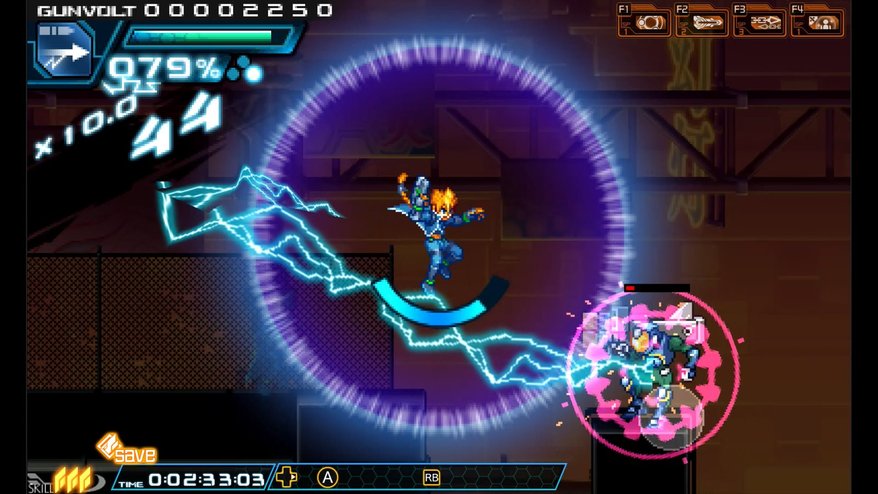Last updated on March 16, 2016
 It’s almost a crime that Azure Striker Gunvolt, Inti Creates’ latest Mega Man-style platformer, went completely ignored by the gaming market at large while a game built around nostalgia that hasn’t even been released (Mighty No. 9) gets all the press. Gunvolt takes the best elements of the developer’s Mega Man Zero and ZX series, adds some new mechanical elements, and then supplements some incredibly solid design with speed. Lots of speed. The result is one of the most enjoyable games I’ve played in recent memory, though not without its flaws.
It’s almost a crime that Azure Striker Gunvolt, Inti Creates’ latest Mega Man-style platformer, went completely ignored by the gaming market at large while a game built around nostalgia that hasn’t even been released (Mighty No. 9) gets all the press. Gunvolt takes the best elements of the developer’s Mega Man Zero and ZX series, adds some new mechanical elements, and then supplements some incredibly solid design with speed. Lots of speed. The result is one of the most enjoyable games I’ve played in recent memory, though not without its flaws.
To begin, we do need to discuss the story; much like in the Mega Man Zero series, story plays a prominent role in the flow of the game, even though the traditional “pick your stage of choice” trope also appears in Azure Striker Gunvolt. Inti Creates sets the game in the near future, where people called “Adepts” have developed “septimal powers”, a fancy name for superhuman powers like flight, elemental weaponry, and so on. An evil corporation called The Sumeragi Group, supposedly brought world peace, but actually experiments on Adept in order to further its secret plans (which, surprisingly, make sense if you’re paying attention). Gunvolt escapes from the Sumeragi Group and works for an organization known as QUILL, which is seeking to reveal and put a stop to Sumeragi’s ulterior motives. Things get more complicated, of course, with competing visions of the world fighting each other – Gunvolt, an Adept of great power himself, has to decide what side he’s on in the grand scheme, or maybe no side at all…

Honestly, I was surprised to find myself invested in the plot for a pretty straightforward action game, but Gunvolt takes a different road than its Mega Man ilk. Surprisingly heady concepts meet an excellently localized script by 8-4, known for their work in dozens of Japanese games, and it just plain works. Sure, the plot beats are predictable, but it’s a surprisingly sad game with a not-so-positive ending, contrary to the anime stylings; the well-written characters engage you as much as can be done through simple talking heads, but they’ve done a little with a lot. I commend Inti Creates on finally getting this right; the Mega Man Zero games by comparison demonstrated horrible translations which made it hard to understand what was happening!
But, of course, you can skip all of this if you so choose, and there’s almost no barriers to the action in that regard. The real fun comes from Azure Striker Gunvolt’s fast-paced take on the Mega Man Zero series, and boy does it ever deliver! The game contains your usual run/jump/shoot/dash elements, but with a unique twist. Gunvolt uses the power of lighting to zap his enemies; however, merely shooting them won’t deal any damage. Instead, your main shot “tags” enemies so that you can use your Flashfield ability, which creates an electrical field around gunvolt which zaps nearby enemies, and tagged enemies, into oblivion. You can tag any single enemy up to three times for added attack strength; weapons gained as you progress let you tag multiple enemies many more times for even more fun!
 But, there’s a catch to all of this. First, activating the Flashfield drains your EP meter; this determines how long you can use the Flashfield. If the EP meter completely drains, you’re open to tons of damage and also can’t use any useful attacks for a protracted period of time. Thankfully, recharging the EP meter requires double-tapping down at any time, but this movement also opens you up to attack. You’ll never WANT to run out of EP, since the game equips you with Prevasion by default, which prevents damage to Gunvolt as long as he has EP (but also drains EP at the same time). This sounds horribly unbalanced, but it’s really not, since many enemies can break through this shield or drain your EP entirely if they hit you, and it’s not a pretty sight!
But, there’s a catch to all of this. First, activating the Flashfield drains your EP meter; this determines how long you can use the Flashfield. If the EP meter completely drains, you’re open to tons of damage and also can’t use any useful attacks for a protracted period of time. Thankfully, recharging the EP meter requires double-tapping down at any time, but this movement also opens you up to attack. You’ll never WANT to run out of EP, since the game equips you with Prevasion by default, which prevents damage to Gunvolt as long as he has EP (but also drains EP at the same time). This sounds horribly unbalanced, but it’s really not, since many enemies can break through this shield or drain your EP entirely if they hit you, and it’s not a pretty sight!
What’s most interesting, though, is that many of your more advanced movement options tie directly to the EP meter. The Flashfield, for example, lets you float in the air as long as you hold the button down, allowing you to cross long chasms and dodge certain ground attacks. Double-jumping, air-dashing, and other aerial movements you earn throughout the game also require it, lending a constant balance between offense and defense with the EP meter. Knowing how much you have left, when to charge, and when not to use it becomes an interesting ballet as you optimize damage while trying not to run out at the same time. A skill meter also generates point when you deal damage, which gives Gunvolt giant area of effect attacks and health/EP boosts, but these are just as limited as the EP meter, so you’re also managing lots of skills at once. Mastering these disparate elements is required for speedy progression through the stages, as well as high score ranks for completing missions.
 Those rewards are usually crafting components. Collecting medals throughout the stages, and performing well, give you additional items (up to fifteen per stage) which you can use to craft new equipment for Gunvolt – these are given at random, but you do get a lot of them! Usually, these upgrades appear in the form of EP use reduction or the like, but the accessories provide much-loved aerial movement options. The game incentivizes solid play, or exploration at least, in order to gain additional tools. Since you earn levels (health, damage, EP upgrades) just by playing the game, this provides less skilled players with some form of aid to actually win.
Those rewards are usually crafting components. Collecting medals throughout the stages, and performing well, give you additional items (up to fifteen per stage) which you can use to craft new equipment for Gunvolt – these are given at random, but you do get a lot of them! Usually, these upgrades appear in the form of EP use reduction or the like, but the accessories provide much-loved aerial movement options. The game incentivizes solid play, or exploration at least, in order to gain additional tools. Since you earn levels (health, damage, EP upgrades) just by playing the game, this provides less skilled players with some form of aid to actually win.
In some ways, this system does punish those who don’t learn the nuances of Azure Striker Gunvolt’s myriad systems by forcing a time commitment, but you can also grind for these items if you’re truly that bad at the game. This, to me, is a nice compromise; those of us who can play skillfully, and don’t want to level grind (which is a thing in this game, believe it or not), can play the game like a straightforward action game. Those less Adept (har har) at the game can simply bash their head against the wall – either way, Azure Striker Gunvolt wants you to learn its systems, or spending a lot of time hating yourself.
